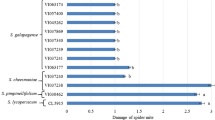Abstract
Bioassays employingTetranychus urticae Koch were used to examine repellency of leaves and trichome secretions of one cultivar of tomato,Lycopersicon esculentum, and 11 accessions ofL. hirsutum consisting of seven accessions ofL. hirsutum f.typicum and four accessions ofL. hirsutum f.glabratum. Leaves of f.typicum were more repellent to mites than were those of f.glabratum orL. esculentum. Removal of trichomes and their secretions by wi** leaves of f.typicum accessions with 95% ethanol rendered them less repellent, indicating that trichomes or their secretions were potentially responsible for repellency. Gas and thin-layer chromatography of leaflet washes obtained by stee** leaflets in hexane indicated that the chemical composition of the washes differed among accessions. The main difference between botanical forms was the presence in leaflet washes from f.typicum accessions of compounds eluting late on the gas Chromatograph and migrating further on reverse-phase thin-layer chromatography; compounds having these characteristics were absent in washes of f.glabratum andL. esculentum. The compositions of secretions taken directly from type I, type IV, and type VI trichomes were similar to that of the leaflet wash obtained from the same f.typicum plant, indicating that leaflet washes contained mainly compounds of trichomal origin. Leaflet washes from f.typicum plants were generally more repellent toT. urticae than were washes from f.glabratum when tested by choice and nonchoice bioassays. Taken together, the data indicate that trichome secretions of f.typicum are likely responsible for potent repellency to two-spotted spider mites observed in this taxon; the likely active compounds are sesquiterpene acids or other polar constituents of trichome secretions.
Similar content being viewed by others
References
Carter, C.D., andSnyder, J.C.. 1985. Mite response in relation to trichomes ofLycopersicon esculentum xL. hirsutum F2 hybrids.Euphytica 34:177–185.
Carter, C.D., andSnyder, J.C. 1986. Mite responses and trichome characters in a full-sib F2 family ofLycopersicon esculentum xL. hirsutum.J. Amer. Soc. Hortic. Sci. 111:130–133.
Coates, R.M., Denissen, J.F., Juvik, J.A., andBabka, B.A. 1988. Identification ofα-santanlenoic and endo-β-bergamotenoic acids as moth oviposition stimulants from wild tomato leaves.J. Org. Chem. 53:2188–2192.
Farrar, R.R., Jr., andKennedy, G.G. 1992. Insect and mite resistance in tomato, pp. 122–142,in G. Kalloo (ed.). Genetic Improvement of Tomato. Monographs on Theoretical and Applied Genetics 14. Springer-Verlag, New York.
Good, D.E., andSnyder, J.C. 1988. Seasonal variation of leaves and mite resistance ofLycopersicon interspecific hybrids.HortScience 23:891–894.
Krebs, K.G., Heuser, D., andWimmer, H. 1963. Z. Spray reagents, pp. 854–909,in E. Stahl (ed.). Thin-Layer Chromatography. A Laboratory Handbook, 2nd ed. Translated by M.R.F. Ashworth, Springer, New York, 1969.
Miller, J.C., andTanksley, S.D. 1990. RFLP Analysis of phylogenetic relationships and genetic variation in the genusLycopersicon.Theor. Appl. Genet. 80:437–448.
Rick, C.M. 1982. The potential of exotic germplasm for tomato improvement, pp. 1–28,in I.K. Vasil, W.R. Scowcroft, and K.J. Frey (eds.). Plant Improvement and Somatic Cell Genetics. Academic Press, New York.
Weston, P.A., andSnyder, J.C. 1990. Thumbtack bioassay: A quick method for measuring plant resistance to two-spotted spider mites (Acari: Tetranychidae).J. Econ. Entomol. 83:500–504.
Weston, P.A., Johnson, D.A., Burton, H.T., andSnyder, J.C. 1989. Trichome secretion composition, trichome densities, and spider mite resistance of ten accessions ofLycopersicon hirsutum.J. Am. Soc. Hortic. Sci. 114:492–498.
Author information
Authors and Affiliations
Rights and permissions
About this article
Cite this article
Guo, Z., Weston, P.A. & Snyder, J.C. Repellency to two-spotted spider mite,Tetranychus urticae Koch, as related to leaf surface chemistry ofLycopersicon hirsutum accessions. J Chem Ecol 19, 2965–2979 (1993). https://doi.org/10.1007/BF00980596
Received:
Accepted:
Issue Date:
DOI: https://doi.org/10.1007/BF00980596




